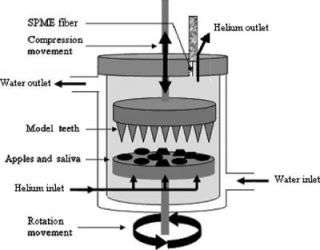A schematic representation of the artificial mouth apparatus, which scientists have designed to mimic human digestion. Credit: Courtesy of the American Chemical Society
For years scientists have tried to build an electronic tongue, a robotic tasting device that could have profound applications in improving food quality and safety. But before machines learn to taste their food, they first need to learn how to chew it.
In a study scheduled for the May 14 issue of ACS’ bi-weekly Journal of Agricultural and Food Chemistry, scientists report the design of an artificial mouth that mimics the first vital steps of human digestion — chewing, saliva release and the initial breakdown of food.
In the study, Gaëlle Arvisenet and colleagues point out that a number of factors are involved in the release of aromatic and flavor compounds in the mouth. Chewing, the release of saliva, the rate of food breakdown and the temperature all affect the flavor and smell of food before it’s swallowed.
To accurately reproduce the effects of chewing, Arvisenet's team needed to build a machine that could imitate several — if not all — of these subtle processes. “Our aim was not to reproduce the human mouth conditions exactly, but to reproduce the result of mastication,” says Arvisenet.
The researchers compared apples chewed by their machine and by human mouths. The resulting apple pulp was scrutinized for texture, color and aromatic compound release. “Experimental conditions were determined that produced fruit in a state closest to that obtained after mastication in a human mouth,” reports Arvisenet.
Source: American Chemical Society
























